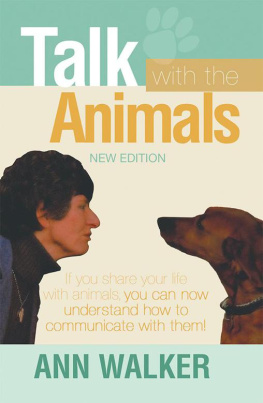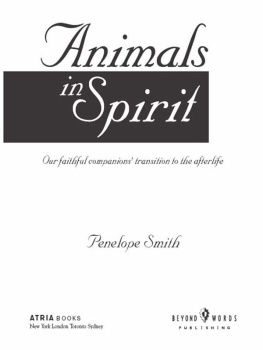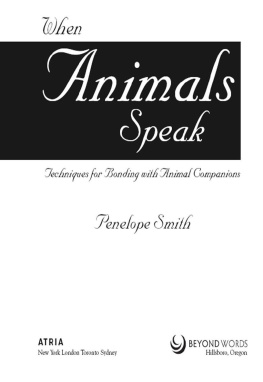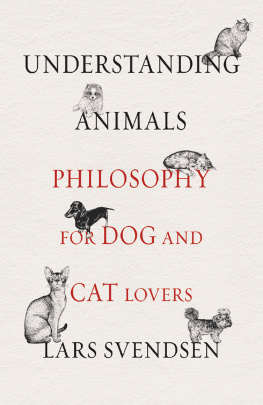Talk with the
Animals
If you share your life
with animals, you can
now understand how to
communicate with them!
Ann Walker
Copyright 1983, 2014 by Ann Walker.
Library of Congress Control Number:2013920996
ISBN:Hardcover978-1-4931-4390-0
Softcover978-1-4931-4389-4
Ebook978-1-4931-4391-7
All rights reserved. No part of this book may be reproduced or transmitted
in any form or by any means, electronic or mechanical, including photocopying, recording, or by any information storage and retrieval system,
without permission in writing from the copyright owner.
Rev. date: 01/13/2014
To order additional copies of this book, contact:
Xlibris LLC
1-800-455-039
www.xlibris.com.au
504579
CONTENTS
DEDICATION
For Cindy,
and all other four-footed friends
who give so much more than they are given
The immortal Dr Dolittle has caught the imagination of generations of children and parents with his ability to talk to the animals. That is, actually to converse with them as one being to another.
I would like to make the rather startling suggestion that there was nothing particularly remarkable about this. On the contrary, talking to the animals is something we can all do. I can, and so can you. The basic requirements are simple enough: a real love and understanding of animals as individuals and personalities in their own right, and a willingness to learn.
The legendary Dr Dolittle was by no means the only person credited with the gift of being able to talk to and understand the language of animals. Ever since the dawn of history, the wise menthe holy ones, the seers, prophets and spiritual leaders of every religious persuasionhave been said to have the gift of being able to communicate with members of the animal world.
Hiawatha, the legendary Christ figure of the North American Indians was immortalised in verse by the poet Longfellow and was recorded by him as learning of every beast its language. The Buddha told many parables and stories about animals. When he went alone into the jungle he was accompanied by the wild monkeys and elephants who looked after him, kept him company and brought him food. We can take it as read that communication was a two-way thing between them!
In Old Testament literature we have the dramatic story of Daniel who was thrown to the lions but remained unhurt. The obvious conclusion to be drawn from this is that Daniel could talk to them and be understood. It has always been popularly believed that Solomon, wisest of kings, was able to communicate with the animals, but in fact the Bible tells us that he talked of the animals and birds, not to them.
Many Christian saints have been credited with an ability to talk to the animals, and among them is the outstanding example of St Francis, who not only talked to them but preached to them as well!
Whatever their time and place in history, whatever their personal ideologies, all these people had one thing in common: they knew the value of silence and how to observeand listenin silence. They were also caring people, not just for the animals but for their fellow men, too. They did not draw up arbitrary distinctions between people and animals, animals and people, or even between people, animals and plants; they cared for and loved life, in whatever form they met it.
Nearly all of us who live with animals do a lot of talking at them. I know I do! Whenever I am alone with one of my animal friends, I gabble away to it and feel very foolish if I am overheard.
This may be an excellent way of getting it off your chest, but it has absolutely nothing to do with talking with animals, which is a two-way thing, real communication.
The rewards of learning to do this could, I feel, be greater than the more dubious possibility of learning to communicate with beings from elsewhere in the galaxy.
After all, the animals are here with us, sharing our world. To a greater or lesser extent their lives are bound up with ourstheir problems are our problems.
More immediately, the rewards of actually taking the trouble to get through to animals can be very worthwhile and quite spectacular.
My daughter and I were breaking in a young pony. We bred Fleur and had owned her mother for many years, so she was very much part of the family. She was being thoroughly awkward and uncooperative about having the bit in her mouth for the first time. I was trying to hold her still while Ruth got the bridle over her head and the bit in her mouth.
She was not succeeding. Fleur was hopping about all over the place, throwing her head up out of reach each time Ruth attempted to get the bit between her teethwhich were clenched tight, anyway! I was finding it difficult to keep the pony still, because with only a light webbing headstall on her, it was impossible to stop her throwing her head about.
Both Ruth and Fleur were becoming increasingly het up, and I was beginning to feel more and more like the meat in the sandwich. As we all got progressively more uptight, success seemed further and further away.
I finally suggested that Ruth and I swap over; as I took the bridle in my hand I made a supreme mental effort to clear my mind of all extraneous thoughts and to fill the void with a clear picture of Fleur opening her mouth as I slipped the bit between her teeth.
Now come on, open your mouth, I said, doing my best to sound confident.
Fleur opened her mouth and I slipped the bit in, just as I had visualised doing: she was the only one of the three of us who did not seem surprised!
But why should she be? What I had done was quite simple: I had spoken to her in a language she understood. A visual thought language habitually used by animals to convey messages one to another.
This was a simple instance of breaking through the barrier of language and getting through to an animal so that she understood just what was required of her; as a result a great deal of stress was averted.
Of course, not every attempt to communicate with an animal is so successful. There are so many factors to take into consideration, the most obvious one being the difficulty of projecting a message in this way. Most of us have minds rather like cluttered family living rooms, whereas if you are to communicate successfully, the message to be sent has to be there by itself, crystal clear, rather like a colour slide projected onto a screen. In fact, when I am having difficulty getting rid of the clutter in my own mind, I concentrate on seeing nothing but a blank white screen on which I put (or try to put) the message I want to send.
Another factor we are apt to forget is the state of the receiving mind, which also may well be cluttered with confusing images, so that our message cannot find space. When I was sending my message to Fleur, probably her mind was also pre-occupied with the same subject and, not being cluttered up with other thoughts, it was that much easier for me to get through.
Finally, something we are all apt to overlook when we try to talk with the animals, is that they are not mechanical receivers permanently switched on waiting to receive from us. On the contrary, animals are individuals and personalities in their own rights with the power to switch off, refuse to listen orin their own waytell us to Shut up! Which of us who owns a dog has not felt exasperated, sometimes almost beyond endurance, when an interesting smell so fully occupies his attention that he cannot, or will not hear our call or whistle?
Donkeys are past masters in this business of switching off, and it may be this ability more than anything else that has earned them their reputation for stubbornness and stupidity.
This so-called stubbornness and stupidity can also be cited as a prime example of failure to get throughto communicatewhich, after all, is what talking with animals as distinct from just talking at, or even to them is all about.
Next page








